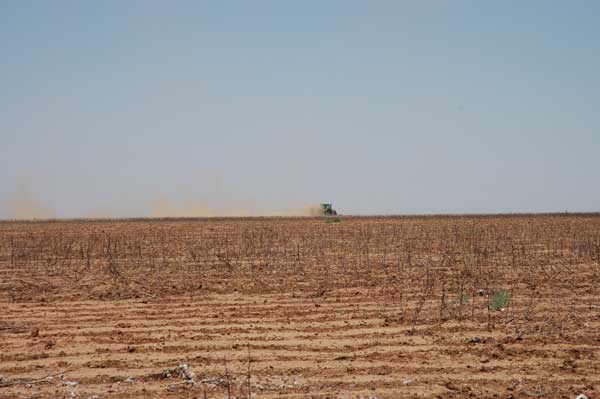
Don Marble, Don Langston and Bill Gilbreath have farmed through a lot of dry spells.
Together, the three have put in more than 150 years raising cotton in the unforgiving environment of West Texas. And this year they’re facing one of the toughest droughts they’ve seen in a long time.
But it might not be the worst.
Gilbreath, 80, recalls 1944 and 1945 when he was a teenager farming with his father near Cone, Texas, in Crosby County.
“We were dryland farming,” he recalls, “and we didn’t plant any cotton those two years. We made a little bit of wheat, five or ten bushels an acre.”
He says one year they got about an inch of rain and tried to plant in the furrow. “Cotton sprouted but we didn’t get any more rain and it all died. In 1946 my father started with irrigation wells. We had big water until the 1970s but we’re about out of water now.”
Marble, 79, recalls 1980 as a particularly bad year for cotton in South Plains, Texas. “We were very dry in 1980,” he says. “We’d had good moisture all through 1979 and into the spring of 1980. We had a good wheat crop and got the cotton planted. But hot weather came on as we cut the wheat and it never let up. There was not a cloud in the sky.”
Langston, 71, who farms in Lubbock County, said 1998 “was a bugger. We got rain to get the cotton up but we got no more until August. We made from one-and-a-quarter to one-and-a-half bales per acre under the pivots.”
He says 1974 was also a bad year. “It was so bad that year a lot of farmers plowed the cotton up to get ready for the next year. Some tried sunflowers and found out that volunteer sunflowers were hard to control.”
Langston says every year he bought a new cotton stripper turned out to be a bad year for cotton production.
They remember the 50’s drought as the worst long-term dry spell they’ve endured. Marble says the current drought is extremely bad but it follows about six years of very good crops and so far is only a year long.
He has rainfall records for Floyd County, where he farms, going back to 1925. He started farming on his own in 1951, a year when the cotton allotment was lifted. “The Korean War started and we could plant all the cotton we wanted until about 1955,” he says.
“We made a good crop in 1951 and then it just quit raining.” His dad had started drilling irrigation wells back in 1948. “We made big wheat and cotton crops in 1949, across the whole area. Rain and hail storms hit the 1950 crop and we didn’t harvest anything.”
Floyd County received 18.12 inches of rain in 1951, according to Marble’s records. In 1952, rainfall total dropped to 13.35 inches. Only 13.24 inches fell the next year and 1954 total was even worse, 10.56 inches. Things got a bit better in 1955, with 22.04 inches, but 1956 was a disaster with only 8.45 inches of rainfall.
“The drought broke in April of 1957,” Marble says. The county received more than 4 inches of rain in April of that year followed by 6.32 inches in May and 9.72 inches in June. Total for the year topped 31 inches.
“We got a lot of rain in May of 1957,” he says. “We finally got cotton going and we got rain until September.”
The next few years followed typical rainfall patterns with yearly averages around 20 inches. In 1965, Floyd County got only 12.12 inches but totals remained above 16 inches until 1978. In 1980, yearly total was more than 19 inches but a big chunk of that came in two months—3.95 inches in May and 4.83 in September.
Floyd County fared a little better in 1980 than the area around Lubbock, where only 15.86 inches fell.
Langston has farmed on his own since 1959. “I’ve made 52 crops,” he says. “My son-in-law is farming it this year.”
Langston’s grandfather farmed and so did his father until 1934. “Cotton came up that year in September,” Langston says, “so dad started working in a bank. He took over the farm from my grandfather in 1956.”
He also remembers the drought years of the 1950s. He and Marble wonder if the 2010/2011 drought might be the beginning of another ‘50’s-like dry period. “It very well could be,” Langston says.
“I wonder if what we’re seeing now is similar,” Marble says.
About the Author(s)
You May Also Like






